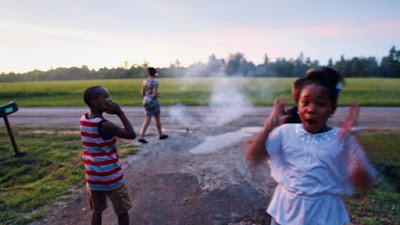In 2009, RaMell Ross moved to Alabama to teach photography and coach basketball in one of the local schools. While he was settling in, he picked up a video camera - old snapper habits die hard - and began shooting footage of day-to-day activity in and around his new community. Seventy-odd minutes of these ad hoc video diaries have now been stitched together to form the basis of Hale County This Morning, This Evening, the year's first real documentary find. Some of the resulting film chronicles exactly what Ross was called to Hale County to oversee. We watch local basketball players run through drills and practice their dunks; we hear cheerleaders working on their routines off-camera. Occasionally, Ross will follow one of the players home to hear out their hopes for the future. (This strand of the film falls very much in the tradition of 1994's landmark doc Hoop Dreams.) Yet the filmmaker has also captured a lot of Hale County downtime: townsfolk hanging out in the backs of or on the bonnets of cars, shooting the breeze, playing up for the camera, in one instance even singing the blues, another tradition that refuses to die out so long as there are reasons to keep on singing those blues. Day turns to night and back again, and all the while this camera retains the closest fix on almost exclusively black lives that had previously passed under the radar. This once, somebody picked them up.
The assumption with Hale County... - we might even relabel it a prejudice, one the movies have done much to confirm - is that we will spend these seventy minutes being beaten around the head with hardship. Nothing could be further from the truth. Ross sometimes ventures into pockets of local poverty, and even encounters a measure of personal tragedy, as one might anywhere on this Earth, but mostly, you're struck by the great beauty of the film; it's been shot and assembled with someone with a real eye for life as it's lived on and off Main Street. The big-picture material comes easily to him: the parades and funfairs, the shadows cast by the noonday sun. A low angle nocturnal peek through a basketball hoop at the stars rotating in the firmament above tips us off as to where Ross is aiming. Yet he's equally alert to the micro, and to what these details might signify in the wider American tapestry he's stitching together here. Motes of cotton float in like snow from the surrounding farmland, more benevolent nowadays than they might have seemed in the 19th century; a properly joyous sequence contents to follow a giddy toddler charging back and forth across her young parents' apartment, either to impress the visiting cameraman, or just to burn off some of her apparently prodigious energy. There is a future here, and a past.
Crucially, Ross lets the latter sequence play out uninterrupted, as he does the players' pre-game warm-ups (which are not unlike the toddler's peregrinations), or a sequence that observes a neighbour installing furniture in their new home. One of the pleasures of Hale County..., emerging as it does into an era of tricksy docu-fiction hybrids hellbent on complicating our relationship with the people they concern and the truths they reveal, is that it's relatively unburdened by clever-clever framing devices. Ross tosses in the odd curveball title card, asking us questions so that we don't get too complacent or pointing out, in the most informal fashion, which of his subjects were less than thrilled to be caught on camera. In the main, though, this footage is allowed to be what it is; what it's trying to capture, and what it succeeds in capturing, is plainly and simply that thisness enshrined in the title - everyday life itself. It's only with the accumulation of all these moments, all these lives, that Hale County... begins to resemble any kind of directorial statement: a delicate nudge to suggest that this quiet backwater, this hidden frontier, is every bit as much America as the sprawling metropoli we see on our screens week in week out, and to underline that the people Ross films are as worthy of our time as those we might find anywhere else.
A caveat: this is, patently, America as it was in the years between 2009 and the middle of this decade (the toddler is wearing a Lego Movie sweater, which dates the footage) - i.e. the old world, before the Fall, when these States were at least partially united in the project of making America beautiful again. (Truly, we never knew we had it so good.) You can, I think, sense the mood darkening as the film progresses, carrying us towards our more guarded and suspicious moment. Some of the residents' higher hopes don't appear to have been borne out, and Ross's superbly limber editorial strategies create one especially indelible rhyme, between this region's frequent lightning strikes and patrol car lights flickering in the darkness. A storm, of one kind or another, is coming, and it's possible Ross elected to assemble these images at this moment (rather than continuing to shoot) out of fear that something within them - their relaxed air, perhaps even the very idea of hope - might be comprehensively lost in the years ahead. The film that reaches us this week still has poetry in its veins, rather than grief or anger - and yet watching it in early 2019, a full decade after its first images were alighted upon, you can only wonder what will become of Hale County this week, this month, this year. Sequels beckon, perhaps, much as life goes on; either way, you emerge from Hale County... elevated, and excited indeed to see what Ross next brings back to us.
Hale County This Morning, This Evening opens in selected cinemas from tomorrow.

No comments:
Post a Comment